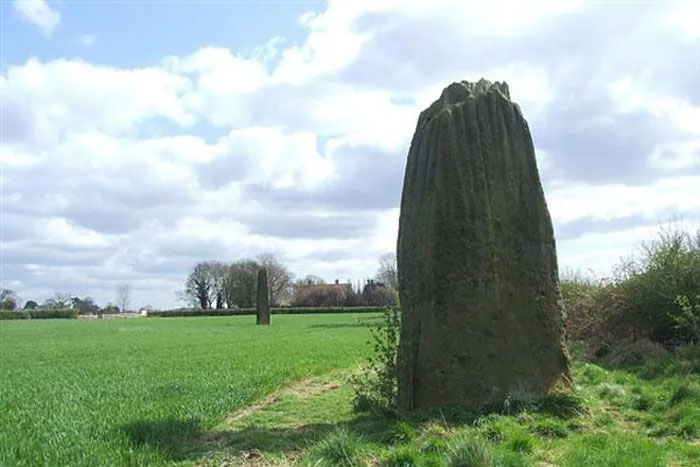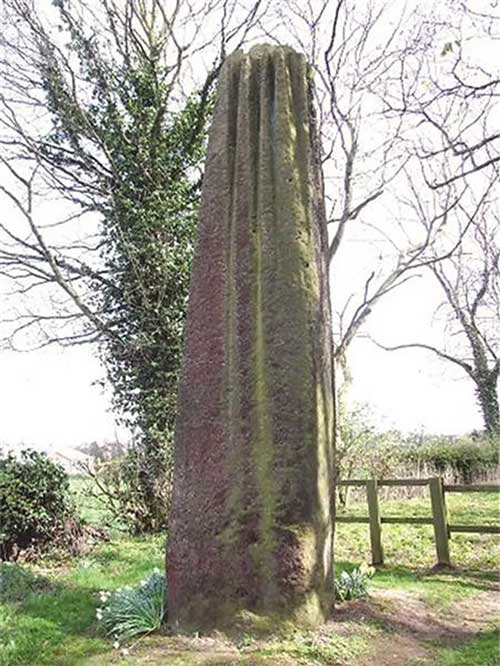In the heart of Yorkshire (England), three towering stone columns stand tall at heights of 5.5, 6.7, and 6.8 meters. They are arranged in a line, oriented from Southeast to Northwest.
Since 1709, England has actively excavated and sought to explain these stone columns, yet to this day, no clear answers have emerged.
The Devil’s Arrows

The Devil’s Arrows with 3 upright stone columns, towering high.
According to records from England, the three columns in Yorkshire may be remnants of a row consisting of 4 to 5 stone columns. They are located near the town of Aldborough, Yorkshire, less than 200 meters from the A1 motorway.
The dating of these three stone pillars is quite ancient, belonging to the Neolithic or Bronze Age (around 1200 BC). This is the tallest standing stone arrangement in England, known locally by various names such as Devil’s Bolts, Three Sisters, and Three Greyhounds, but most commonly referred to as The Devil’s Arrows.
A 17th-century Yorkshire myth tells of a resident of Aldborough who angered the devil. In a fit of rage, the devil uprooted the tall stone pillars from the nearby village of How Hilltop to use as arrows, aiming them at Aldborough. Thanks to a quick intervention from an angel (or perhaps the devil’s poor aim), the stone arrows missed their target, landing in a row at the edge of Aldborough.
The first arrow stands over 6.8 meters tall, making it the second tallest standing stone in England (after an 8-meter stone in Rudston). It has a cross-section of 1.4 x 1.2 meters, situated on a clear patch of land overgrown with weeds.
The second arrow is 110 meters away, standing 6.7 meters tall, with a cross-section of 1.5 x 1.2 meters and slightly leaning towards the south.
The third arrow is located another 60 meters away, standing at 5.5 meters tall, with a cross-section of 2.6 x 1.4 meters.
Locals in Yorkshire also claim that if one walks around the Devil’s Arrows counterclockwise 12 times, the devil will appear. This superstition likely emerged during the medieval period, when Christianity was actively suppressing pagan beliefs. The church intentionally associated the strange stone columns in Aldborough with Satan, viewing them as a gateway to the underworld.
Excavation

Traces of grooves and indentations on the body of the Devil’s Arrows may be due to human activity or weathering.
According to English historical records, in 1709, Yorkshire conducted the first excavation of the Devil’s Arrows. They marked a boundary 2.7 meters from the central standing stone and dug deep into the ground.
At a depth of 1.5 meters, a significant amount of stones, gravel, and clay was found packed around the stone column. Beneath this chaotic layer, the base of the stone column revealed a square flat slab. It appears that the stone was shaped, given a base, and smoothed before being buried, reinforced with rubble, and covered with soil.
In 1876 and 1881, Yorkshire excavated the bases of the other two arrows. They discovered that they were “planted” in the same manner as the central standing stone. The shorter column was buried shallower (1.4 meters), while the taller column was buried deeper (1.8 meters).
All three arrows are made of millstone grit, a type of stone commonly used for millstones in England. While this type of stone is prevalent, it is particularly unavailable in Aldborough. Over time, the arrows have been weathered by the elements. However, they still retain evidence of their original shaping, including vertical grooves and surrounding indentations.
Another perspective suggests that the grooves and indentations are naturally occurring. Millstone grit is not particularly hard, and it could easily be weathered by rain and wind, forming marks that appear as if they were made by human hands.
The Fourth Stone
Many believe that the row of Devil’s Arrows in Aldborough must have originally included four stone columns. They cite a report from medieval explorer John Leland, who wrote in the 1530s that there were four columns arranged in a line.
About 30 years later, another medieval explorer, William Camden, reported that the fourth stone had been disturbed by treasure hunters. They believed that gold and silver were hidden beneath the arrows, so they toppled and excavated one of the columns to investigate.
There are several speculations regarding the fate of the fourth arrow. Some suggest that when constructing a bridge over the River Tutt, the residents of Aldborough used it as building material. Several local gardens also claim to hold remnants of this arrow. A local estate owner in Aldborough asserts that the fourth stone is buried deep beneath their property.
Yorkshire folklore suggests that the row of Devil’s Arrows may include five or more stone columns. If this is true, the space of the Devil’s Arrows would be quite expansive. Directly to the Northwest along the row of Aldborough’s arrows leads to the River Ure. It is highly likely that these stone columns were part of a monumental prehistoric ceremonial landscape in this river valley.
Returning to the three Devil’s Arrows in Aldborough, English archaeologists remain skeptical. They do not know when they were “planted,” by whom, or for what purpose.
Currently, there are two plausible hypotheses regarding the Devil’s Arrows of Aldborough:
- First, they may be a monument commemorating a Roman victory.
- Second, they may serve as a lunar observatory for some religious purpose.
Demolishing the ceiling, a group of people was “astounded” by what they saw above!
Strange tree selling for nearly 9 trillion but no one wants to plant its seeds
Somewhere else in the Solar System once had a “life-sustaining shield” like Earth


















































